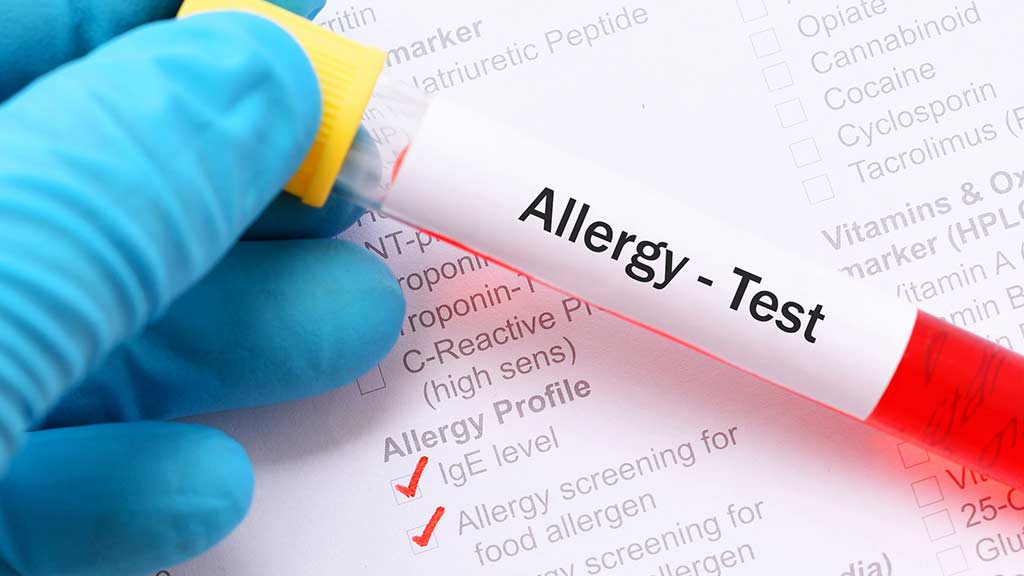Get our independent lab tests, expert reviews and honest advice.
Food allergy and intolerance tests

Food allergies and intolerances – whether the genuine or ‘lifestyle’ variety – are on the rise, and there are various tests on offer to help people identify the problem foods. Medical doctors can offer conventional skin prick tests for allergies, while a dietitian can oversee food intolerance testing. But sometimes these tests find nothing and the troubling symptoms remain.
On this page:
- Common food allergies
- Common food intolerances
- Testing
- Other medical tests
- Unproven tests
- Why getting the right test matters
While perplexing to those with genuine allergies, some people are willing to go to great lengths to be “diagnosed” with allergies or food intolerances – and plenty of people are willing to take their money and tell them what they want to hear. Offered by naturopaths and other natural health practitioners, or over the internet, unfortunately many of these popular tests lack credibility.
In this article we look at some of the most popular alternative tests on offer and find out which ones actually work.
Allergy vs intolerance vs sensitivity
An allergy is when the body’s immune system reacts to proteins in food or other substances like pollen, nickel, pet dander, bee stings and medication. This can result in itching, coughing, wheezing, vomiting, rashes or runny nose, and at its most severe, anaphylaxis.
Coeliac disease is not an allergy but an autoimmune disease affecting about one percent of the population (with possibly more who are undiagnosed), where the immune system reacts abnormally to the protein gluten and attacks and damages the lining of the bowel.
A food intolerance, on the other hand, is not based on an immune response and doesn’t show up on allergy tests. Symptoms can include headaches or migraines, hives, nausea and other gut symptoms. ‘Food sensitivity’ or ‘hypersensitivity’ are terms sometimes used instead of intolerance or allergy respectively.
Common food allergies
According to the Australasian Society of Clinical Immunology and Allergy (ASCIA), there are nine foods that cause 90% of food allergic reactions:
- cow’s milk
- egg
- peanut
- tree nuts
- sesame
- soy
- fish
- shellfish and
- wheat.
More than one in ten one-year-olds have food allergies, though many outgrow them – about two percent of adults have food allergies.
Common food intolerances
It’s harder to measure the prevalence of food intolerance in the population, as many people claim food intolerances but don’t have them formally tested and diagnosed. Common food intolerances include:
- Lactose – A sugar found in milk for which some people lack the enzyme needed to break it down, causing gut symptoms (bloating, pain, diarrhoea).
- Amines – Chemicals that cause blood vessels to expand, resulting in flushing, congestion and migraines. Sources include some fruits and vegetables, wine, chocolate and cheeses.
- Sulfites – Preservatives used in drinks and dried fruit, can cause wheezing and other respiratory symptoms.
- Salicylates – Aspirin-like compounds found in certain herbs, spices, fruits and vegetables. Can cause a range of symptoms including asthma-like symptoms, congestion and headache.
- Glutamates – Found in camembert, parmesan cheese, tomatoes, soy sauce and mushrooms. Symptoms may include headache, hives and nasal congestion or runny nose.
- FODMAPs – Among people diagnosed with irritable bowel syndrome (IBS), there seems to be an intolerance to certain sugars referred to as FODMAPs – fermentable oligo-, di-, and mono-saccharides and polyols. A diet low in FODMAPs has been found successful in resolving symptoms in 50-86% of patients. A low-FODMAP diet usually significantly reduces the amount of grains, fruits and vegetables, dairy and legumes that you eat. It should be done under the supervision of a dietitian trained to administer the diet to avoid nutritional deficiencies.
- Gluten – One of the most controversial food intolerances is gluten. Also known as non-coeliac gluten sensitivity, gluten intolerance is associated with gut symptoms such as bloating, diarrhoea and nausea, as well as fatigue and psychological symptoms such as depression and brain fog.
Gluten intolerance
With gluten increasingly demonised over the last decade in alternative health and food faddism circles, many Australians who are not coeliac or allergic to wheat buy gluten-free versions of foods at least sometimes, and up to nine percent of Australians claim to be gluten intolerant. But this number is likely to be an overestimate of the true prevalence of gluten intolerance.
It’s not uncommon to experience fewer gut symptoms when giving up gluten-containing foods, as people eat less in general, but it may not be due to the gluten.
Because the symptoms attributed to gluten intolerance overlap those of IBS, it may well be that people who get symptoms from eating bread and pasta and other gluten-containing foods are actually reacting to FODMAPs in wheat rather than the gluten protein.
Studies have found that some self-declared gluten-intolerant people have their symptoms resolve when following a low-FODMAP diet, and when challenged with gluten protein suffer no symptoms. While to most intents and purposes eating ‘gluten’ means eating FODMAPs as well, some gluten-free products may contain FODMAPs that should be avoided. And if FODMAPs are the problem, it would be better to deal with all relevant foods, not just grains.
Testing
The key to managing food allergies and intolerances is an accurate diagnosis of the foods causing the problem. The type of test you have depends on whether you have a suspected allergy or an intolerance.
Recommended tests
Allergy tests
The gold standard test for allergies is a skin prick test. This involves placing a drop of suspected allergens on the skin, which is then pricked with a lancet allowing the allergen extract to enter the skin. A reaction at the site, such as an itchy lump, likely means an allergy to the substance – whether food, pollen, cat dander, dust mites, bee sting and so on.
If the skin prick test can’t be carried out – for example if the patient has eczema, has taken anti-histamines in the last week, or if a severe reaction may be expected – another test is a specific immunoglobulin E (IgE) test, formerly known as the RadioAllergoSorbent Test (RAST). This test measures antibodies against specific allergens, with a separate test required for each suspected allergen.
Skin prick and specific IgE tests are covered by Medicare.
Coeliac test
Family history and blood tests can indicate the possibility of coeliac disease, but diagnosis can only be confirmed by taking a biopsy of the small bowel and checking for damage.
Food intolerance testing
The gold standard for food intolerance testing is a temporary elimination diet followed by a controlled food challenge to identify dietary triggers. Under the supervision of an accredited dietitian and a medical practitioner, foods suspected of causing symptoms are removed from the diet, and when symptoms are gone the food is reintroduced to see if symptoms return.
Other medical tests
Some tests, while scientifically plausible and useful in some situations, aren’t as reliable or informative as the recommended tests, and are not recommended by ASCIA under general circumstances.
Breath hydrogen tests
Malabsorption of fructose and lactose, often associated with gut symptoms such as bloating, gas, pain and diarrhoea in people with IBS, can be detected using breath hydrogen tests. It’s based on the notion that hydrogen on the breath comes from fermentation of poorly absorbed carbohydrates. After following a special diet low in fermentable sugars, the patient is given a dose of sugar (fructose or lactose) and the hydrogen arising from malabsorption can be measured. While these tests are widely used, there have been issues with reliability of the method and interpretation of results.
Total IgE antibodies
While genuine allergy tests measure IgE antibodies directed at specific allergens, total IgE tests measure the total number of antibodies in a blood sample. Any increase in IgE antibodies could be due to allergies, but also parasitic infections and other medical conditions. On the other hand, people with allergies may have normal total IgE levels.
Eosinophil testing
Eosinophils are a type of white blood cell that may be higher in people with allergies. However, as with total IgE, raised levels could be due to another cause, and they may appear at normal levels in people with allergies. So, a test result that shows a high eosinophil count isn’t necessarily helpful for an allergy diagnosis.
Unproven tests
“I did the IgG test one-and-a-half years ago. I was strong for brazil nuts, kidney beans, cow milk and almonds. Also issues with egg white and tomatoes. Ironically it didn’t show up wheat/gluten which I know 100% that I am intolerant too. I have also done an IgE test which did not show up gluten. I followed up by going to a naturopath who uses a Vega machine – finally, a test that showed I was intolerant to gluten.” – Rebecca
There are many other tests on offer over the internet or from alternative health practitioners such as naturopaths and chiropractors that haven’t been proven to work. ASCIA estimates that around half of all people with allergies consult alternative therapists each year.
The tests below have been criticised for various reasons, including lacking any scientific plausibility, lacking correlation with medically accepted tests and giving inconsistent findings when repeated in the same person.
IgG tests
One of the most common alternative allergy and food intolerance tests is an IgG test (not to be confused with IgE tests), with brands like ImuPro and Hemocode. They’re widely offered by naturopaths and other alternative practitioners, or can be done yourself by mail order. These claim to test for almost three hundred different foods using a drop of your blood, at a cost of hundreds of dollars.
The claim is that if you’re allergic or intolerant to a particular food, you’ll have certain antibodies which can be detected in the test, and it also tells you the degree to which you’re sensitive.
Experts say that while IgG does play a role in allergic response, the tests don’t tell you anything useful. The antibodies detected simply reflect what you’ve eaten – so exposure rather than intolerance. They also find that for people who are growing out of allergies – which happens in kids especially – the level of IgG antibodies goes up.
Tests have found that people with known genuine intolerances, proved by elimination diet and oral challenge, don’t show raised IgG antibodies.
According to ASCIA, “there is no credible evidence that measuring IgG antibodies is useful for diagnosing food allergy or intolerance, nor that IgG antibodies cause symptoms”.
Cytotoxic and ALCAT tests
Cytotoxic tests (“Bryan’s test”) are based on observing changes to white blood cells after exposing them to potential allergens, while the antigen leucocyte cellular antibody test (ALCAT) measures changes in the white blood cell diameter after being challenged with specific food substances to detect intolerances.
Hair analysis
Hair analysis claims to test for allergies or intolerances to up to 600 different food and non-food substances using technology that is “based on quantum physics and incorporates the principals of [Electro-acupuncture According to Voll] EAV, radionics and homeopathy”. It claims to measure the electromagnetic energy of the hair sample when it’s in contact with the substance. Some test for heavy metals and mineral deficiency, and claim these are somehow linked to allergies. There’s no scientifically plausible means of being able to detect allergies or intolerances in hair, and no evidence it can do so.
Vega tests
Vega machines or BioEnergetics testing claim to detect allergies and food intolerances by measuring changes in galvanic skin response. Other names include Electrodermal, Voll, Quantum and Dermatron testing – sometimes the machine names are used. An electrode is placed on your finger, and a sealed container of food is introduced into the circuit. Reduced or ‘disordered’ electrical current means an allergy or intolerance.
Bicom testing
The Bicom is a bio-resonance machine said to pick up “specific frequency patterns” from a patient (or from substances that harm or stress the organism) via electrodes. It claims to be able to test and treat allergies including food allergy, hay fever and skin rashes.
The device has been the subject of a number of complaints in Australia and the UK, and despite the company being unable to provide any evidence it can detect or treat allergies and food intolerances, it continues to be advertised and used by natural practitioners and is listed as a medical device with the TGA.
Applied kinesiology
Practised by some chiropractors and other natural therapists, allergies and food intolerances can be diagnosed using principles of applied kinesiology by having the patient hold a sealed container of a test substance in one hand, while the practitioner tests the muscular strength of the opposite arm.
Why getting the right test matters
“We got live blood analysis done years ago on myself and kids. We also went down the hair analysis road. I tried every different alternative therapy and it cost us a fortune – and no results. As a mum of a child who has life-threatening multiple food allergies, I would say go the experts at an allergy clinic. Get a skin prick test and a RAST test. This will tell you what the allergies are and the level. At the allergy clinic we were bulk billed. It cost us less to fly to Sydney as a family and get tested than it did for the previous alternative tests which showed nothing.” – AllergySave
Apart from the fact that special foods or diets free of allergens may also be more expensive than regular foods, there are numerous repercussions if someone decides they have a food intolerance or allergy that isn’t real – whether self-diagnosed or diagnosed with the help of unproven or unorthodox tests.
Firstly, missing a real allergy could be life threatening. This is most likely to be an issue for children, who are more likely than adults to have allergies. Furthermore, symptoms attributed to food intolerance may be due to a more serious illness. If you’re concerned about symptoms, see a (real) doctor.
People who avoid certain foods may be at risk of nutritional deficiencies. It’s recommended that people with genuine food intolerances consult an accredited dietitian to ensure this doesn’t happen. Meanwhile, avoiding a food due to unwarranted concerns about allergy could result in a genuine allergy developing – there are many examples of this occurring in children.
Finally, allergy fakers and people with self-declared intolerances can also make it difficult for people with genuine allergies who may not have their allergies taken seriously. This is especially the case in restaurants and cafes, where it’s not uncommon for people to declare an allergy or intolerance to dairy or gluten, say, only to eat cake and ice-cream for dessert – “I’m only a little bit allergic.” As with the boy who cried wolf, the resulting complacency among restaurant staff may end badly.
CHOICE verdict
The consequences of bogus testing go beyond just your wallet. If you come across an allergy or intolerance test on the internet, or are offered one by your natural health practitioner, it’s worth doing some research to find out whether it’s evidence-based or not. As a first port of call, ask your GP about it, or check the ASCIA website – it has many fact sheets on allergy and food intolerance testing.




